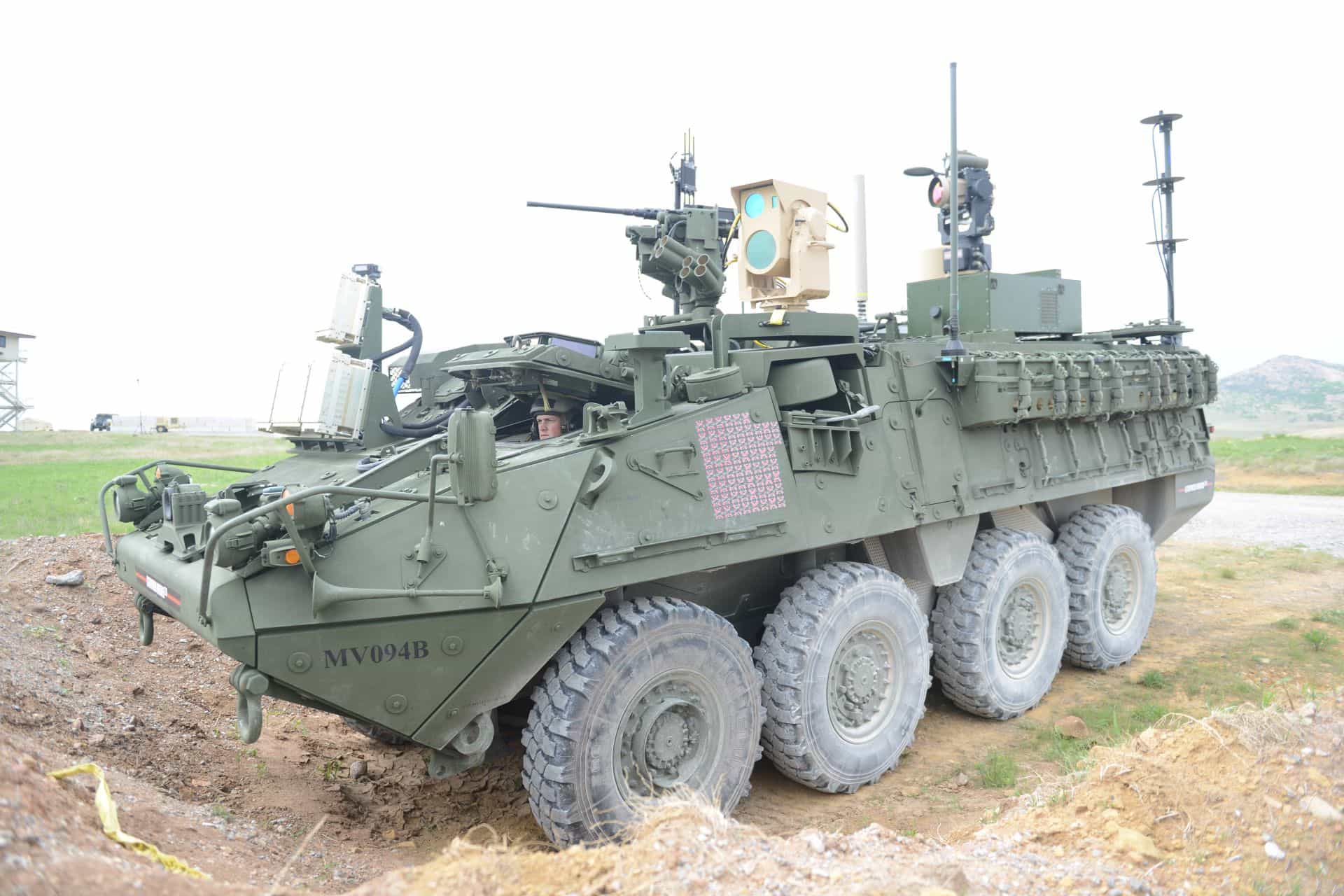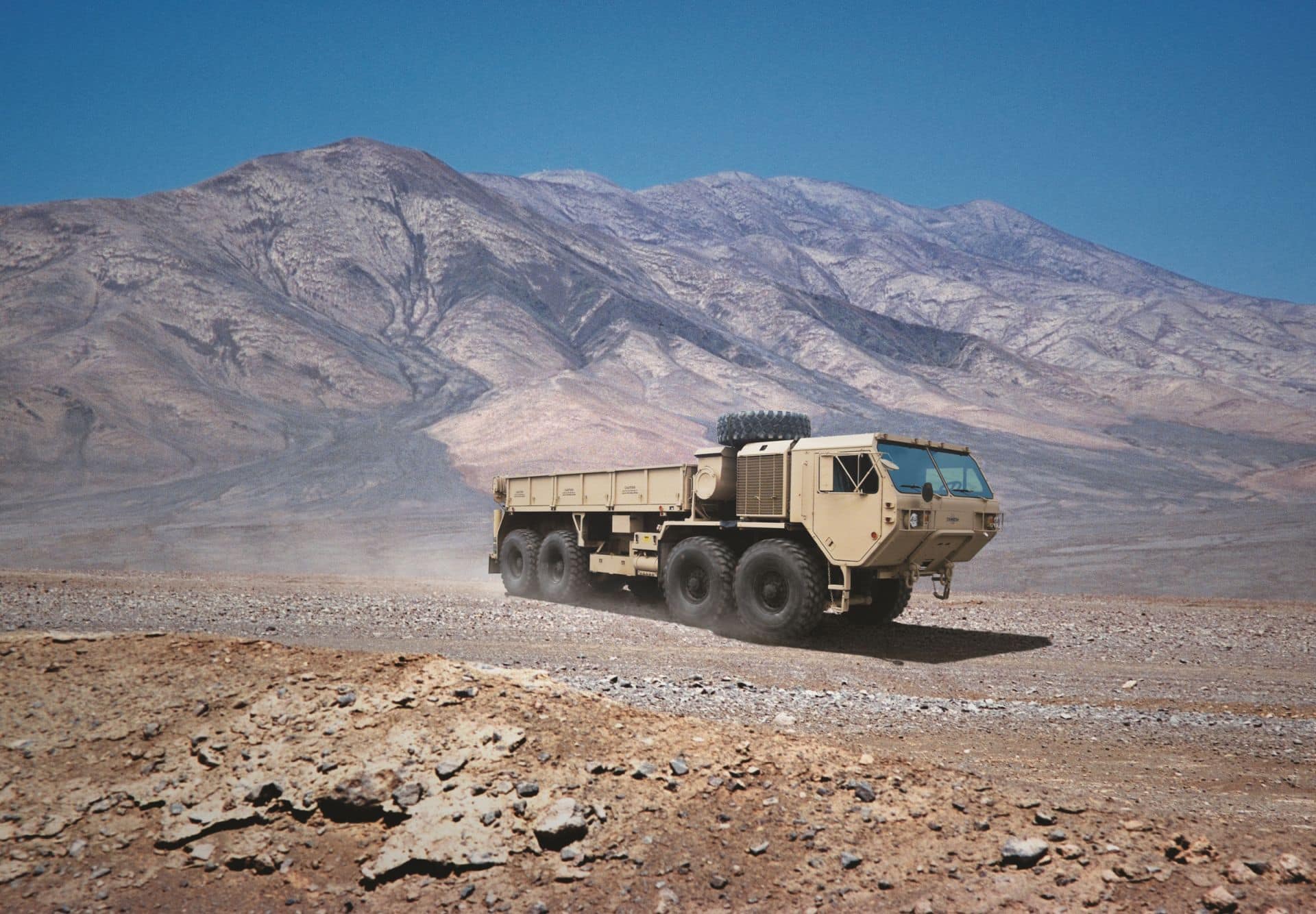A Stryker combat vehicle equipped with a 5kW laser and an array of sensors spent several minutes scanning the horizon for a wayward “enemy” drone.
On a television screen in a nearby tent off Thompson Hill — a range used during the 10-day Maneuver Fires Integrated Experiment here — observers watched the black and white output of those sensors on two flat-screen televisions, April 12. A crosshair was centered on the screen. When what appeared to be a drone entered the frame, the crosshairs locked on to it and followed it.
After a few attempts to destroy the drone with the laser, the drone fell from the sky, crashing to the ground. Not a bullet was fired, and no sounds were made by the system that accomplished the kill — an experimental project called the Mobile High-Energy Laser, or MEHEL.
The MEHEL is just one system the Army is looking at to deal with the growth of inexpensive off-the-shelf unmanned aerial systems that are being seen in places like Iraq and Afghanistan.
2017 MFIX EXPERIMENTS
Lt. Col. Jeff Erts, who serves as the chief of experimentation and wargaming with the Fires Battle Lab at the Fires Center of Excellence here, said the MEHEL was just one of three drone-killing systems under evaluation at the 2017 MFIX, which ran April 3-13.
Also included, he said, was a system called the Anti-UAV Defense System and another branded “Hunter/Killer.” There were also command and control systems that provide a common air picture down to platoon and company level, radar systems that can conduct counter-artillery missions, but can also look into the sky, and an unmanned aerial system that can haul supplies to Soldiers on the front lines of combat.
That equipment and the personnel tasked to evaluate it, came to Fort Sill to participate in the 2017 MFIX, which Erts said is a collaboration between the Fires Center of Excellence and the Army Capabilities Integration Center. At MFIX, he said, over 40 industry partners and government leads participated, as well as Soldiers from around the United States.
At this MFIX, the Army was looking to accomplish several goals. At the top of that list was finding better ways to pinpoint targets to put fires on, Erts said.
“We’d like to know where our targets are at,” he said. “So the targets are out on the battlefield somewhere. We’d like to know exactly where they are, so we can use one of our precision munitions to hit it.”
Another priority, he said, involved a bit of doctrinal work. Erts said the Army is interested in knowing if traditional fire supporting Soldiers are capable of executing a counter-unmanned aircraft system mission alongside their traditional artillery mission.
“We’re going to see if their plate is too full, or if they can do everything at once,” he said. “[But] so far, it looks like they can do it.”
Also on the agenda at the 2017 MFIX was a continued look at the use of high-energy lasers, he said. The MEHEL made its first appearance at MFIX last year, but then with a less-powerful laser.
“We are working with Space and Missile Defense Command, using their MEHEL to engage various targets, to include low-flying UAS,” he said. This is the first year, he said, that uniformed Soldiers were actually tasked with using the system to take down actual aerial targets.
“They love the system and they are excited about not only what they can do with it in the air, but what they can do with it on the ground as well,” he said.
Finally, Erts said, at this year’s MFIX the Army looked at new ways to deliver supplies to the edge of the battlefield using unmanned aerial systems, rather than convoys.
At the center of that effort was a project called the Joint Tactical Aerial Resupply System, which was also on display at MFIX.
“Let’s say a Soldier is out of ammunition and they need a resupply in an emergency situation,” Erts said. “They could launch the UAS, and without putting any Soldiers in harm’s way, they could deliver that box of ammunition to the front lines.”
NOT STAR WARS
If the 2017 MFIX had a “star,” it was probably the MEHEL. This year, the Stryker configured with that system was marked “MEHEL 2.0,” and it sported a 5kW laser versus last year’s 2kW laser.
The MEHEL 2.0 includes on-board radar, a second optic, increased laser power, and increased engagement range, Erts said. In addition to doing a “hard kill,” such as what was seen when the on-board laser shot a drone out of the sky, the system can also do a “soft kill.” That means instead of using a laser to destroy a drone, electronic warfare capabilities can be used to disable the communications link between a drone and its ground control station. Then, Erts said, “we can send artillery after the ground control station.”
Also a possibility after a soft kill on a drone is collecting that drone to gather intelligence information from it.
One thing the MEHEL does not do is make noise, or create any Star Wars-like visual effects. When the laser fires, there’s no sound that comes from the vehicle. And observers can’t actually see the laser emanating from the “beam director” on top of the Stryker, though if they were close enough to the target, they might see a hole being burned into it from the laser’s heat.
ENVISIONING LASER USE
Capt. Theo Kleinsorge, who came last month to Fort Sill to participate in the MFIX, serves as the commander of Headquarters and Headquarters Company, 2-12 Cavalry at Fort Hood, Texas. During the MFIX, he replicated the role of an infantry company commander inside the MEHEL 2.0-equipped Stryker.
His primary role was to help determine if the MEHEL was something a forward-observer crew could handle, or if the capability needed to be moved somewhere else, such as into the air defense community. He said he was impressed with the MEHEL system, and sees the usefulness of directed-energy weapons elsewhere in the Army.
“It is absolutely a valuable system,” Kleinsorge said, even beyond the ability to destroy a UAS. “Directed energy will hopefully very quickly see itself useful in the realm of breaching obstacle belts, in the realm of active defense, of not just shooting down UASs, but the ability to destroy incoming anti-tank missiles, mortars, field artillery rounds, across the whole of what the counter-rocket, artillery, and mortar mission is currently.”
One benefit of the MEHEL system is that it doesn’t use ammunition to take down either a UAS or ground target. Practically speaking, the only thing MEHEL needs is fuel. The batteries required to fire the laser can be recharged from generators, which are powered by the same fuel that runs the Stryker’s engines.
“If the entire Army today adopted directed energy and it was able to solve all of our engagement problems, Class V ammunition would no longer exist, and Class III, our fuel, would now be essentially our only logistical requirement for the vehicle to be offensive,” Kleinsorge said.
At MFIX, Kleinsorge said, his team took down about 50 actual targets using the laser onboard the MEHEL. Using directed energy to kill a target is something he said that none of the Soldiers involved had ever done before. Now, he said, he’s sold on the idea.
“From my foxhole as a young captain, I say I am excited to see this in the Army,” Kleinsorge said. “We were skeptical at first, when we were first briefed we’d be shooting down drones with lasers. And by the end of it, it is absolutely more than feasible. We achieved a success rate well beyond what we expected we’d have. And we are excited to see this go to the next step of the experiment, shooting beyond the horizon, and showing this technology can solve the problem.”
SOLDIER’S VIEW
Spc. Brandon Sallaway, a fire support specialist and forward observer from Fort Carson, Colorado, was one of the crew that participated in the MFIX and who worked on the crew that piloted the MEHEL.
He said he found the system was easy to use, and easy to learn as well.
“It uses stuff, controllers, that we’re all familiar with,” he said. “It takes about half an hour … to figure out the system, and then you’re good to go.”
Sallaway was also the first uniformed Soldier to actually use the MEHEL to take down a target. Outside the vehicle, plastered onto the side, are an array of stickers that mark each kill the vehicle has made. He pointed to the one that represents his own kill.
“I’m really excited to be part of a historical event,” he said. “And it’s really exciting … to see the Army working on the next generation of tools for us so that we can maintain our edge, the cutting edge. It’s mind-blowing stuff to think you are shooting a laser at something. Sometimes it’s hard to fathom.”
UNMANNED AIRBORNE RESUPPLY
At MFIX, Soldiers aimed to do more than just blow up or disable enemy drones. Also on the agenda was using friendly drones to deliver supplies to Soldiers in need, so that manned convoys wouldn’t be needed.
“The problem we are trying to solve with the Joint Tactical Aerial Resupply System is how we conduct assured resupply over the last tactical mile to the point of need,” said Capt. Dustin Dunbar, with the Combined Arms Support Command, Sustainment Center of Excellence, Fort Lee, Virginia.
The JTARS used at MFIX was a 1/3 scale model “trainer,” that really served as an example of what could be done, Dunbar said. The JTARS is meant to be a system, rather than particular vehicle.
At MFIX, the JTARS team demonstrated the capability the Army is after by using the trainer model. They had to move a pair of individual first aid kits from one location to another. They attached a few light-weight kits to a specially-built drone to serve as the payload. Then the drone lifted up off the ground and flew a preplanned route to a target destination, without needing a Soldier to guide it with a controller.
The current demonstration model carries about 5 pounds. The expectation is that eventually the JTARS could provide the capability to carry up to 600 pounds from a rear location to the front lines, where Soldiers might need anything from food to ammunition.
“So if you can imagine a Stryker is out on the battlefield and it goes down,” Dunbar said. “And that field maintenance team is working on it but they need a part from the rear. Rather than taking an entire convoy and going through convoy planning missions and stuff like that and getting on the road, instead you are just loading one piece of equipment — a repair part — within the JTARS and sending it point to point.”
Critical to the JTARS concept is reaction time and assured resupply, Dunbar said.
Right now, Dunbar said, the model they have is capable of demonstrating what they want to do, though it might not be the final product. The existence of what they do have allows them to practice delivery of unmanned supplies and also allows them to practice getting access to airspace — something that sustainment units would have to learn to do if they were going to employ JTARS in a theater of operations.
“Your typical sustainment unit within the Army doesn’t have air assets,” Dunbar said. “Plus, they lack the personnel, the structure, and the capability to plan, coordinate and deconflict airspace. So we came out here with the Fires Battle Lab, essentially running the mission command piece of how to conduct this and the best practices to take back to hopefully make it to doctrine.”











